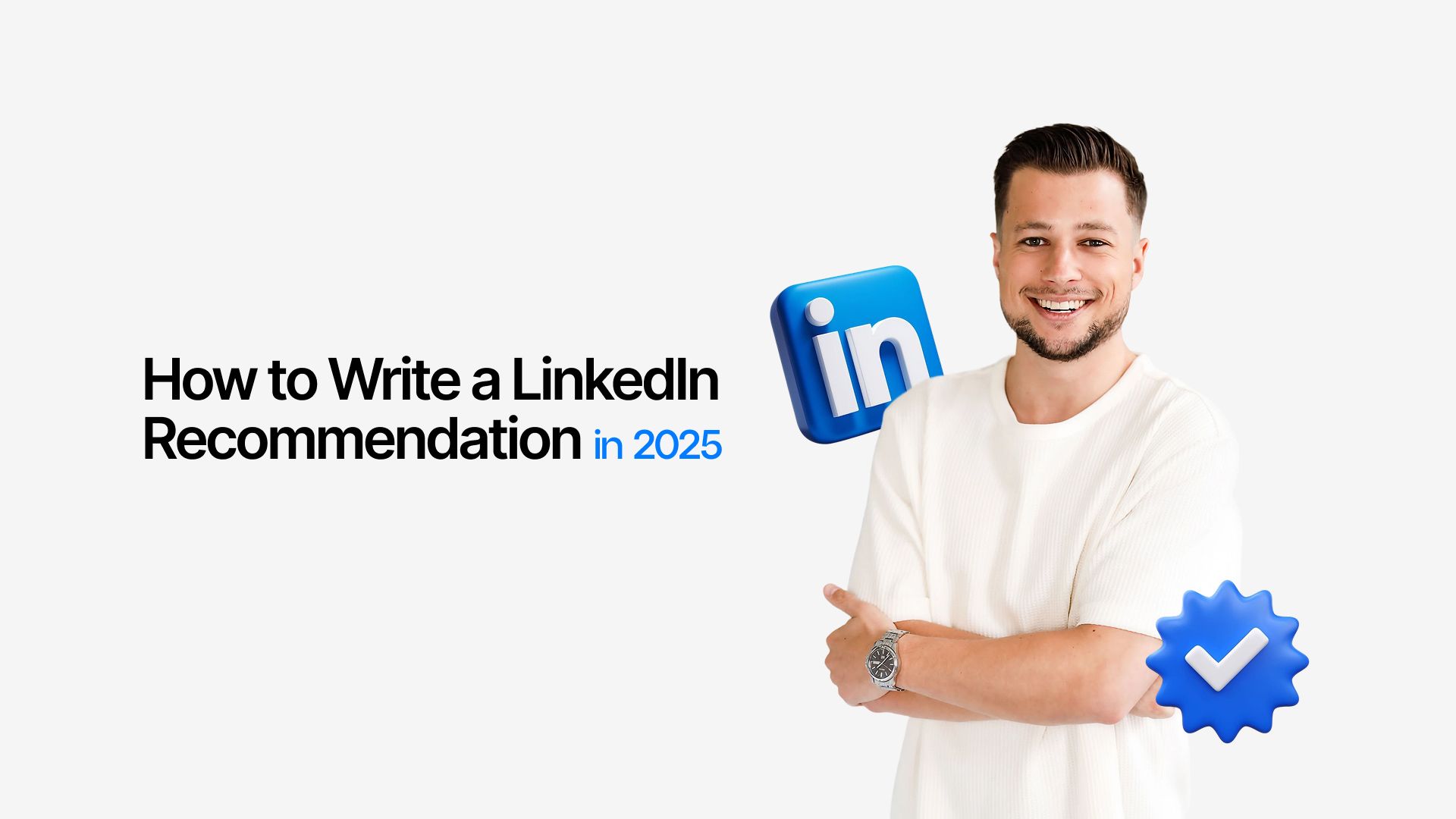
Understanding How to Write a Persuasive LinkedIn Recommendation
Most LinkedIn recommendations read like they were written in a rush, offering the same recycled compliments about being a great team player or having strong communication skills, and the result is that they disappear into the background with little influence on how a profile is perceived.
This guide explores how to write those recommendations in a manner that feels substantial and persuasive, explaining structure, giving real examples, offering templates, and pointing out the mistakes that weaken impact, so you can create recommendations that genuinely help someone’s profile stand out.
What Is a LinkedIn Recommendation?
A LinkedIn recommendation is a written note that one professional adds to another’s profile. It serves as a public testimonial, highlighting skills, achievements, and personal qualities.
Recruiters and hiring managers often check recommendations to understand how someone works with others. A good recommendation is specific, clear, and tailored.
It explains how the writer knows the person, what the individual did well, and why others should trust them professionally. Recommendations help profiles stand out in searches, strengthen online reputation, and support career growth.
Why Writing a LinkedIn Recommendation Matters
Writing a LinkedIn recommendation benefits both the writer and the receiver.
For the person receiving it, a recommendation builds credibility and trust. It shows real experiences and achievements, which helps their profile stand out to recruiters, clients, or business partners.
For the writer, giving a recommendation strengthens professional relationships. It reflects positively on your own professionalism and creates goodwill in your network. Recommendations are often mutual – by writing one, you may receive one in return, which enhances your profile as well.
A strong recommendation also signals leadership, mentorship, and collaboration skills. Whether you are a colleague, manager, or client, the act of recommending builds connections that support long-term career growth. This is why learning how to write a LinkedIn recommendation matters for every professional.
Key Elements of a Strong LinkedIn Recommendation
A good LinkedIn recommendation is clear, specific, and personal. Instead of vague praise, it explains how the person works, what they achieved, and what makes them unique. Recruiters and decision-makers value details that demonstrate real performance.
Specific Achievements and Results
Focus on measurable outcomes when possible. For example, mention a project completed ahead of schedule or a sales target that was exceeded. Specific results carry more weight than general praise.
Personal Traits and Strengths
Highlight qualities that make the individual stand out. This could be leadership, problem-solving, creativity, or teamwork. These traits give readers a sense of the person’s character.
Relationship Context
Always include how you know the person. Were you their manager, a team member, or a client? Stating this adds authenticity and explains the perspective of your recommendation.
Professional Tone with a Human Touch
Keep your language professional but not overly formal. Balance workplace achievements with personal qualities so the recommendation feels genuine and approachable.
Step-by-Step Guide: How to Write a LinkedIn Recommendation
A LinkedIn recommendation works best when it follows a clear structure. By keeping it simple, personal, and professional, you ensure that it has maximum impact. Here is a step-by-step process to follow.
Step 1: Start with Context of Your Relationship
Explain how you know the person and in what capacity. For example, “I worked with Sarah as part of the product development team.” This helps readers understand your perspective.
Step 2: Highlight One or Two Key Strengths
Mention their top skills or qualities, such as leadership, problem-solving, or teamwork. Keep it focused so the recommendation feels genuine.
Step 3: Provide a Specific Example or Result
Add detail that shows real impact. For example, “John led a project that reduced costs by 20% within three months.” Measurable outcomes make the recommendation stronger.
Step 4: Add Personal Qualities that Stand Out
Balance technical skills with personality traits. You might highlight communication, reliability, or creativity. This gives a well-rounded impression.
Step 5: End with a Clear Endorsement
Close with a strong line that encourages others to work with the person. For example, “I highly recommend Maria for any leadership role in technology.”
Mistakes to Avoid When Writing a Recommendation
While writing a recommendation is straightforward, certain mistakes can reduce its effectiveness. Avoid these common errors to ensure your recommendation stands out.
Being Too Vague
Generic statements like “He is great at his job” do not add value. Instead, focus on achievements and strengths that others can trust.
Overly Generic Praise
Avoid writing a recommendation that sounds like it could apply to anyone. Tailor your message to the individual by including specific examples.
Writing Too Short or Too Long
A recommendation that is one sentence feels weak, while one that is overly long may lose the reader. Aim for three to five short paragraphs.
Forgetting Measurable Results
Without outcomes or impact, the recommendation feels incomplete. Always include at least one result or achievement that demonstrates ability.
By avoiding these mistakes, you ensure your LinkedIn recommendation is professional, trustworthy, and memorable.
LinkedIn Recommendation Examples (By Role)
Examples are useful for understanding how to structure recommendations. Below are sample recommendations tailored for different professional relationships.
Writing a Recommendation for a Colleague
“I worked with Alex on several marketing campaigns, and his creativity always stood out. He consistently delivered engaging ideas that improved results and motivated the team. Alex is an asset to any project, and I strongly recommend him for roles that demand innovative thinking.”
Writing a Recommendation for a Manager
“During my time at ABC Corp, I reported directly to Priya. She led with clarity, empathy, and strong decision-making skills. Her ability to balance strategy with team development inspired growth across the department. Priya is an excellent leader, and I highly recommend her for executive roles.”
Writing a Recommendation for a Direct Report
“Maria joined my team as a data analyst and quickly impressed with her problem-solving skills. She improved reporting efficiency by automating workflows, saving the team hours each week. Maria combines technical ability with a collaborative attitude, making her a reliable contributor to any organization.”
Writing a Recommendation for a Client or Partner
“I partnered with James during a cross-company project, and his professionalism was exceptional. He communicated effectively, delivered work ahead of schedule, and always prioritized quality. Working with James was a positive experience, and I would gladly collaborate with him again in the future.”
LinkedIn Recommendation Templates
Templates make writing easier while ensuring you cover the right details. Below are simple structures you can adapt for your own recommendations.
Template 1: General Recommendation
- Start with your relationship: “I worked with [Name] as [role/position].”
- Highlight key strength: “They stood out for [specific skill].”
- Share a result: “Their work led to [achievement or measurable outcome].”
- Close with endorsement: “I recommend [Name] for [position/field].”
Template 2: Leadership Recommendation
- Context: “I reported to [Name] during [project or period].”
- Key traits: “They showed strong leadership through [specific action].”
- Results: “This led to [positive impact on team/company].”
- Endorsement: “I would confidently recommend [Name] for leadership roles.”
Template 3: Client or Partner Recommendation
- Relationship: “I worked with [Name] as a client/partner on [project].”
- Strength: “They excelled at [skill or quality].”
- Result: “This made [specific outcome] possible.”
- Endorsement: “I highly recommend [Name] for future collaborations.”
These templates keep recommendations clear, specific, and professional, while saving time.
How to Ask for a LinkedIn Recommendation
Writing a recommendation is valuable, but asking for one is equally important. A thoughtful request increases your chances of receiving a strong and personalized recommendation.
When reaching out, be clear and polite. Explain why you are asking and provide context to guide the writer.
For example, mention a project you worked on together or a skill you would like highlighted. This helps the person focus their message.
Here’s a sample request: “Hi [Name], I really enjoyed working with you on [project]. Would you be open to writing me a LinkedIn recommendation that highlights my [specific skill or achievement]? I’d be happy to do the same for you.”
Providing context makes the process easier for the writer and ensures your recommendation looks genuine and relevant.
How Can Chatly Help You Write a LinkedIn Recommendation?
Writing a LinkedIn recommendation can feel overwhelming, especially if you’re not sure how to structure it. Chatly AI Chat makes the process easier by guiding you through what to say, suggesting examples, and even drafting a professional template you can personalize.
You can always ask AI anything that you feel stuck about and it will provide the answer you need, till you are satisfied.
With Chatly, you don’t waste time guessing the right tone or format. You get instant practical advice tailored to your role – whether you’re writing for a colleague, a manager, or a client. Chatly can refine your message so it sounds authentic, impactful, and ready to publish.
Ways Chatly supports your LinkedIn recommendation writing:
- Suggests step-by-step structures for professional recommendations.
- Provides ready-to-use templates for different roles and relationships.
- Advises on tone so recommendations feel authentic, not generic.
- Helps with quick edits to add clarity and professionalism.
- Guides on how to ask for recommendations politely and effectively.
Conclusion
Writing a LinkedIn recommendation is not about filling space. It is about telling a story that matters. The best ones capture context, highlight real achievements, and describe qualities that colleagues, managers, or clients cannot easily show themselves. Done right, your words hold weight.
Recommendations also serve as long-term proof of trust. They strengthen relationships, elevate credibility, and reflect well on you. Whether you are recognizing a peer, seeking recognition for yourself, or refining a draft from a template, the thought you invest always pays dividends.
Pointers to keep in mind
- Put achievements before adjectives
- Give context in one sharp line
- Mention a personal trait that stands out
- Keep it short enough to be read in seconds
- Be sincere, not dramatic
Suggested further reading
FAQs About LinkedIn Recommendations
Many want to know about how to write a LinkedIn recommendation, and here are the questions these people ask the most.
More topics you may like

11 Best ChatGPT Alternatives (Free & Paid) to Try in 2025 – Compare Top AI Chat Tools

Muhammad Bin Habib

28 Best AI Tools for Students in 2025 – The Complete AI-Powered Academic Success Guide

Muhammad Bin Habib

How to Become a Freelance Writer in 2025

Muhammad Bin Habib

How to Prompt ChatGPT for a Sales Script

Muhammad Bin Habib

How to Write a Journalistic Article: Definition, Types, Structure and More

Muhammad Bin Habib

What Are JSON Prompts and What's So Special About Them?

Muhammad Bin Habib
